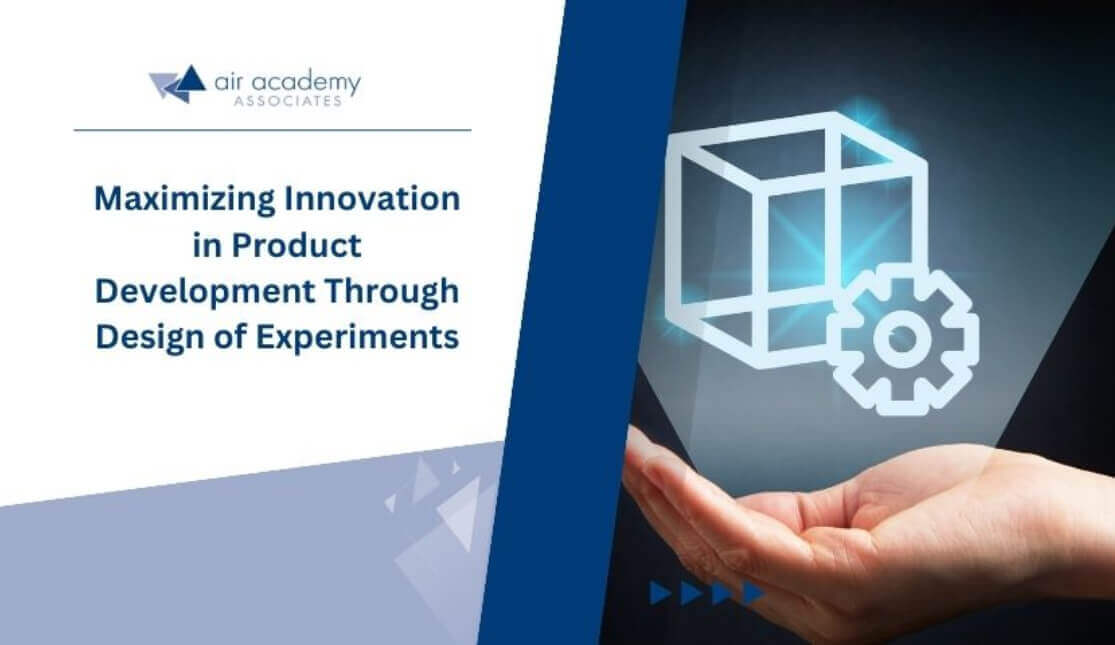
Design of Experiments (DOE) is an essential tool for professionals seeking to enhance efficiency and foster breakthroughs. DOE is a systematic approach that helps understand the relationship between various factors in a process and the outcomes they produce.
This blog about DOE will highlight its critical role in streamlining the development process and unlocking innovative product potential. We will explore how DOE aids in optimizing resources, reducing development time, and ensuring quality in product development across various industries. Whether you’re a seasoned expert or new to the field, this blog will provide valuable insights into leveraging DOE for success in the dynamic landscape of product innovation.
Role of DOE in Product Development

Image Source: Freepik
Design of Experiments (DOE) is not just a statistical tool but a comprehensive strategy that plays a multifaceted role in product development. Its applications range from enhancing product features to optimizing manufacturing processes, each contributing significantly to the ultimate goal of innovation and efficiency.
Accelerating the Development Process
One of the primary roles of DOE in product development is accelerating the development cycle. Traditional product development often involves a trial-and-error approach, which can be time-consuming and inefficient. DOE replaces this with a structured approach, allowing teams to explore a range of variables and their interactions systematically.
By using DOE, developers can quickly identify the most influential factors affecting product performance and focus their efforts on optimizing these key areas. This approach speeds up the development process and ensures that the time invested yields more informative and impactful results.
Enhancing Product Quality
DOE also plays a crucial role in enhancing the quality of the final product. By allowing teams to test various combinations of materials, design features, and manufacturing conditions, DOE helps identify the optimal configuration that meets or exceeds quality standards. This is particularly important in industries where safety and reliability are paramount, such as automotive or aerospace.
Through systematic testing and analysis, DOE ensures that each product variation is thoroughly evaluated, leading to a final product that is not only innovative but also of high quality and reliability.
Reducing Costs and Resource Usage
Cost reduction and efficient resource use are essential in today’s competitive market. DOE assists in identifying the most cost-effective materials and processes without compromising quality. By optimizing the product development process, DOE helps reduce waste, minimize resource usage, and lower production costs.
For instance, by using DOE to streamline a manufacturing process, a company can identify the minimum amount of raw material needed to achieve the desired product quality, thereby reducing material costs and waste.
Facilitating Cross-Functional Collaboration
DOE fosters a collaborative environment by bringing together different expertise and perspectives. It requires input from various departments, such as design, engineering, manufacturing, and quality assurance.
This cross-functional collaboration is vital in product development, as it ensures that all aspects of the product and process are considered and optimized. Through DOE, teams can effectively communicate and make data-driven decisions, leading to more innovative and well-rounded product solutions.
Enabling Predictive Analysis
Lastly, DOE is instrumental in predictive analysis. By analyzing the data obtained from experiments, developers can predict how design or process variable changes will affect the final product. This predictive capability is crucial for making informed decisions about future product iterations or developments, allowing companies to anticipate market needs and stay ahead of the competition.
DOE’s role in product development is multifaceted and profound. It accelerates development, enhances product quality, reduces costs, fosters collaboration, and enables predictive analysis. By integrating DOE into the product development, companies can significantly improve their innovation capabilities, leading to successful and competitive products.
DOE and Innovation – Real-World Examples

Image Source: Pexels
The impact of Design of Experiments (DOE) in driving innovation is best illustrated through real-world examples. This section will explore how various industries have utilized DOE to foster innovation, improve products, and streamline processes.
Automotive Industry: Enhancing Fuel Efficiency
In the automotive industry, DOE has improved vehicle performance and fuel efficiency. For example, a major car manufacturer used DOE to optimize the design of a new engine. By experimenting with different combinations of engine components and operating conditions, they identified the most efficient design that maximized fuel economy without compromising on power or emissions. This innovation led to a competitive advantage in the market and contributed to environmental sustainability.
Pharmaceutical Industry: Drug Formulation and Development
The pharmaceutical industry heavily relies on DOE for drug formulation and development. A notable instance is the development of a new medication where DOE was used to determine the optimal combination of active ingredients. By systematically testing different formulations, researchers could maximize the drug’s efficacy while minimizing side effects, significantly speeding up the time to market and ensuring patient safety.
Consumer Electronics: Optimizing Product Features
DOE has been used in consumer electronics to optimize product features and user experience. For instance, a leading electronics company applied DOE to enhance the battery life of a popular smartphone model. By experimenting with various battery materials and circuit designs, they developed a more efficient power management system, resulting in longer battery life and better user satisfaction.
Aerospace Industry: Improving Component Reliability
The aerospace industry employs DOE to enhance the reliability and safety of its components. A breakthrough example is the use of DOE in the design of a jet engine component. By testing different materials and manufacturing processes, engineers developed a component that significantly reduced the likelihood of failure, thereby improving the overall safety and reliability of the aircraft.
Food and Beverage Industry: Product Flavor and Texture Optimization
In the food and beverage industry, DOE has been used to optimize product flavors and textures. A well-known food company utilized DOE to develop a new snack with the ideal combination of crunchiness and flavor. By experimenting with various ingredients and cooking conditions, they created a product that resonated well with consumers, leading to a successful product launch and increased market share.
These real-world examples demonstrate the powerful role of DOE in driving innovation across different industries. By systematically exploring and optimizing various factors, companies can create superior products, enhance customer satisfaction, and gain a competitive edge. The versatility and effectiveness of DOE make it an invaluable tool in the ever-evolving landscape of product development and innovation.
Implementing DOE in Product Development

Image Source: Pexels
To fully leverage the benefits of the Design of Experiments (DOE) in product development, it is crucial to understand the steps involved in its integration, the selection of appropriate experimental designs, and the tools and software that facilitate this process.
Steps to Integrate DOE into the Product Development Cycle
- Define Objectives and Scope: Begin by clearly defining the experiment’s objectives. This could involve improving a specific product feature, reducing costs, or enhancing performance. Understanding the scope helps in designing the experiment effectively.
- Select Key Variables: Identify the variables likely to impact the product’s performance. This involves input from cross-functional teams, including engineering, design, and quality assurance.
- Plan the Experiment: Based on the complexity of the variables and the resources available, choose an appropriate DOE methodology (e.g., full factorial, fractional factorial, or response surface methodology).
- Conduct the Experiment: Execute the experimental plan while meticulously collecting data. It’s crucial to maintain consistency and control to ensure valid results.
- Analyze Results: Use statistical tools to analyze the data. This analysis will reveal the impact of different variables on the product and help understand their interactions.
- Implement Findings: Apply the insights gained from the experiment to the product development process. This might involve changes in design, materials, or manufacturing processes.
- Continuous Improvement: DOE is not a one-time activity. Continuous application of DOE in different stages of product development ensures ongoing improvement and innovation.
Selecting the Right Type of Experimental Design
The selection of the proper experimental design is critical in DOE. The choice depends on several factors, including the problem’s nature, the number of variables, the precision required, and resource constraints. Common types of designs include:
- Factorial Designs: Ideal for studying the effect of several factors simultaneously.
- Fractional Factorial Designs are useful when the number of factors is high and a full factorial design is impractical.
- Response Surface Methodology (RSM): Best suited for optimizing a process or product performance.
Tools and Software Commonly Used for DOE
Various specialized software tools are employed to implement DOE in product development effectively. Based on the information available from Air Academy Associates, some key software solutions include:
- SPC XL: This tool is designed for statistical process control, offering functionalities that support DOE applications.
- DOE Pro XL: Specifically tailored for DOE, this software facilitates the design and analysis of experiments, providing robust capabilities for experimenters.
- Quantum XL: A comprehensive tool that integrates with Microsoft Excel, Quantum XL offers extensive features for statistical analysis, including DOE.
- Simware Pro: This software provides simulation capabilities, which can be useful in understanding and predicting DOE’s outcomes.
Each tool offers unique features that cater to different aspects of DOE in product development, from planning and design to analysis and simulation. The choice of software typically depends on the experiment’s specific requirements and the users’ preferences.
Conclusion
Design of Experiments (DOE) is pivotal in product development and innovation. Its structured approach and systematic methodologies significantly enhance the efficiency and effectiveness of the product development process. The future of DOE is intertwined with technological advancements, promising even more significant contributions to the field. For professionals in product development, mastering DOE is not just an asset; it is essential for staying competitive and driving innovation in an increasingly complex and demanding market landscape.
Air Academy Associates offers a comprehensive Operational Design of Experiments Course for those keen on deepening their understanding and application of DOE. This course is designed to provide the skills and insights necessary to implement DOE in various operational contexts effectively. We invite you to explore this opportunity and join us in advancing your expertise in this critical field.


